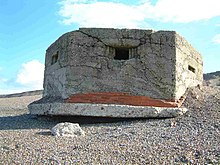Pillbox
A pillbox is the English name for small, ground-level bunkers that were built especially in Great Britain in anticipation of a German invasion during World War II . The designation corresponds to the German word pill or tablet box and is derived from the flat and partly round shape.

A pillbox has a cylindrical or polygonal shape, is relatively flat and has circumferentially embrasures . The pillboxes were built in a standardized construction with a size of a few square meters and were intended to protect infantrymen .
The first pillboxes were set up during World War I and were used to protect machine gun shooters . However, the majority of the pillboxes were built around 1940 in preparation for an expected German invasion ( Operation Seelöwe ). They were often located in the immediate vicinity of strategic places such as rivers, bridges or airfields. Thousands of pillboxes are still visible in the UK today.
Outside of Great Britain, comparable structures were built e.g. B. also built in Czechoslovakia , Japan , Israel and in large numbers in Albania . In Germany, so-called ring stands (often also MG ring stands) were built in a comparable way . All of these buildings have a 360 ° field of fire in common, which distinguishes them from Schartenstands . For example, the Maas-Rur position - a field-like ditch position between the Maas near Venlo and the Rur near Wassenberg built in autumn / winter 1944/1945 to strengthen the west wall - consisted primarily of such ring stands.
The engineers Picket and Hamilton invented a retractable pillbox, the Pickett-Hamilton Fort , which was also known colloquially as the Pop Up Pillbox .
Pillbox on Lower Tame in Staffordshire
World War 2 British bunker, Burton Bradstock, Dorset
See also
literature
- Mike Osborn: Pillboxes of Britain and Ireland. The History Press Lt, 2008, ISBN 0-7524-4329-1 .
Web links
- Pillbox study group UK (English)
- Pillboxes (English)







